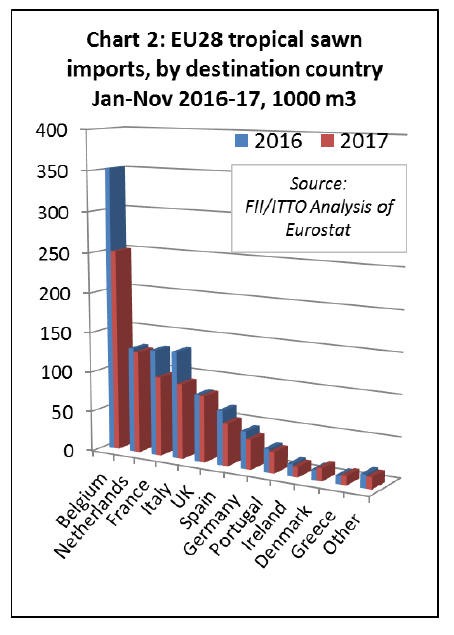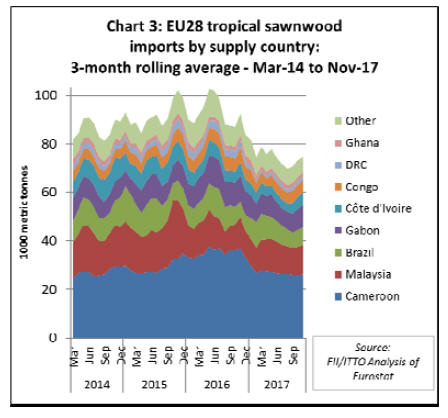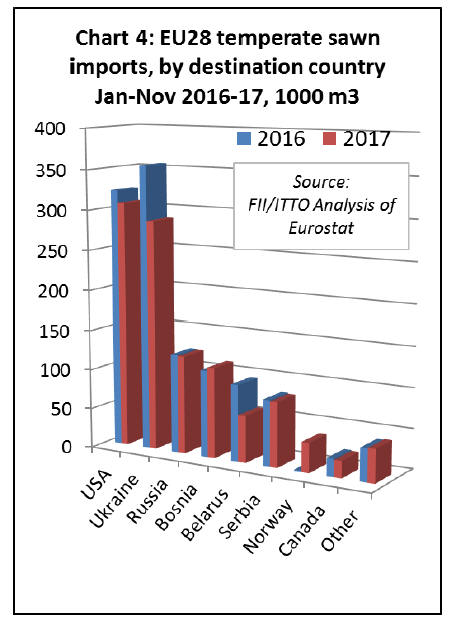|
Report from
Europe
Upswing in EU timber consumption not benefitting
tropical suppliers
Sawn hardwood distributors in Europe are reporting good
levels of activity but this has yet to feed through into a
significant rise in tropical sawn hardwood imports.
Against an improving economic backdrop, the EU¡¯s sawn
hardwood trade was reported stable to very good from
2016 through the first three quarters of 2017, with
customers, notably joinery producers, reporting healthy
order books.
A clear indication of long-term confidence in the
European hardwood market derives from latest
developments at Vandecasteele. The company is already
one of Belgium and Europe¡¯s biggest hardwood importers
and international traders. Now it is expanding its stock
holding capabilities by building a further four hectares of
warehousing at its Aalbeke distribution hub. That will take
total undercover storage to 16 hectares and the overall area
of its site to 20 hectares.
In contrast to this positive picture, however, latest
statistics (to November 2017) show tropical sawn
hardwood imports declined sharply last year.
The EU imported 822,600 cu.m of tropical sawn
hardwood between January and November 2017, 20% less
than the same period in 2016.
In the eleven-month period, tropical sawn hardwood
imports declined from all 10 of the top suppliers to the
EU.
From Cameroon imports fell 21% to 293,800 cu.m, from
Gabon 21% to 93,700 cu.m, from Brazil 6% to 92,500
cu.m, Congo 18% to 49,900 cu.m, Cote d¡¯Ivoire 21% to
45,200 cu.m, Ghana 19% to 18,600 cu.m, Democratic
Republic of Congo 51% to 15,000 cu.m and Ecuador 11%
to 9,600 cu.m.
The best performance was by Malaysia and Madagascar,
but EU imports were still down from both countries, albeit
just 1% to 135,400 cu.m and 8,300 cu.m respectively
(Chart 1).

The decline in tropical sawn hardwood trade affected
nearly all the main EU countries. Belgian imports were
down 29%, at 251,000 cu.m, French 24% at 98,000 cu.m,
Italian 30% at 93,400 cu.m, Spanish 21% at 53,200 cu.m,
German 20% at 37,300 cu.m, Portuguese 9% at 26,600
cu.m, and Ireland 14% at 13,000 cu.m.
UK imports were only down 1% at 81,900 cu.m while
Denmark¡¯s were up 24% at 15,700 cu.m and Greece¡¯s
12% at 11,600 cu.m (Chart 2).

Closer analysis of the monthly data indicates that
following a sharp dip in EU imports of tropical sawn
hardwood in the middle of 2017, imports were rising
slowly again between September and November 2017.
However, it is too early to say whether this is just a
seasonal trend or the start of a longer-term recovery.
(Chart 3).

Weak EU imports of tropical sawn wood, why?
European timber businesses suggest a range of factors that
may explain the apparent dichotomy between good
underlying demand for hardwoods and the sharp fall in
imports of tropical wood in 2017. Some are short-term
trade trends, others longer-term international market
structural changes.
According to some importers, one reason is adjustment
after over optimistic buying in 2015 and 2016. Trade was
further disrupted in 2017 by particularly heavy seasonal
rains in both Africa and Asia.
Worsening congestion at the Cameroon port of Douala,
due to supply bottlenecks following the rains, combined
with lack of dredging resulting in reduced vessel load
factors, added to problems in West Africa.
While also pointing out that a significant proportion of
timber shipped into their country is en route to other
European markets, Belgian importers also attributed the
dramatic fluctuation in its imports from Cameroon from
2015/16 to 2017 to post-recession improvement in supplier
mills¡¯ capacity and efficiency.
Long lead times immediately after the international
downturn, in some cases extending to two years, led to
some Belgian importers increasing order volumes to
secure sufficient stock.
However, as Cameroon mills improved performance,
numerous orders were reported arriving in quick
succession in 2016. That resulted in excess stocks in 2017
and further orders being reined back until these had been
cleared.
The downturn in EU tropical imports is also attributed to
international economic improvement and increase in
demand elsewhere, with supply diverted to other such
healthy markets as the US, Middle East and, most notably,
Vietnam and China.
Rising demand in the latter is put down particularly to the
continued rise of the country¡¯s affluent middle class and
consequent growth in domestic consumption of timber and
wood products. While referring to temperate hardwood,
this is most clearly illustrated in American Hardwood
Export Council (AHEC) statistics for Chinese timber
imports from the US.
As little as a decade ago, AHEC estimates that 85% of
China¡¯s US hardwood imports were re-exported as
manufactured goods, with just 15% staying in China.
Today that ratio is almost exactly reversed and the vast
bulk is consumed in the Chinese market.
EUTR deterring tropical suppliers say EU importers
Some EU importers maintain that the EU Timber
Regulation (EUTR) has also played a part in an
international hardwood trade shift. They may welcome
the EUTR as a tool to combat the illegal timber trade.
However, they say the due diligence requirements it
imposes on suppliers can deter them from the European
market and make Chinese customers especially appear
easier to do business with.
This is even more the case as the latter are also reported
now to be buying a wider range of wood, from logs and
lower quality sawn timber, to top end lumber.
Rising global demand, combined with supply constraints,
has also led to generally firming prices and tighter
margins.
That, say some EU buyers, has increased customer caution
in forward ordering, reinforcing a longer term underlying
trend towards buying little and often, or just-in-time,
where customers expect importers increasingly to act as
their stockholders, from which they can draw timber as
required.
EU imports of sawn temperate hardwood decline 7%
EU imports of sawn temperate hardwoods also declined in
2017, although less dramatically than imports of sawn
tropical hardwoods. Total EU imports of sawn temperate
hardwoods from outside the region were 1,072,300 cu.m
in the first eleven months of 2017, down 7% compared in
2016.
The sharpest falls in EU imports of sawn temperate
hardwood were from Ukraine, down 19% to 287,300
cu.m, and Belarus, 39% lower at 59,100 cu.m. Imports
also fell from the US (down 5% to 307,400 cu.m), Russia
(down 1% to 123,200 cu.m), Serbia (down 1% to 81,400
cu.m), and Canada (down 1% to 21,400 cu.m).
Imports increased from several countries, but these
insufficient to offset the declines elsewhere. Imports
increased from Bosnia (by 4% to 113,400 cu.m), Norway
(a dramatic 2,111% increase to 37,000 cu.m) and other
temperate countries (by 2% to 41,800 cu.m). (Chart 4).
As for tropical timber, the downturn in imports of
temperate hardwoods was also attributed to some stock
adjustment to clear an excess from earlier over-ordering,
together with a rising demand elsewhere, notably China
and other South East Asian importers.

Particularly good EU demand for sapele
Looking at individual species and products, importers in
several EU countries, report particularly good demand for
sapele in 2017, with prices firming as a result. Iroko
continued in especially tight supply, due at least partly, it
is thought, to less coming out of the forest in current
harvest cycles, and prices reflected that.
Some predict that framire/idigbo is gradually being
replaced on the EU market due to mills¡¯ inability to satisfy
due diligence information requirements, although there are
also now reports of suppliers improving their legality
assurance.
Particularly tight supply and firm prices were also reported
by a Belgian importer in afzelia/doussie, ayous, tali,
padouk and azobe.
Malaysian meranti and Indonesian bangkirai availability
declined towards the end of 2017, with prices in the last
quarter up for the former by 9-12% and by 9-17% for the
latter, according to a UK importer. Meranti lead times
were also reported up to four to five months. Brazilian ipe
supply is said to be increasingly short too.
European importers remain concerned about the supply of
teak from Myanmar. This follows concerns about the
reliability of legality assurances which triggered EUTR
enforcement agencies in several countries into taking
action against importers and demanding that teak be more
effectively tracked to forest of origin in Myanmar.
The EU¡¯s successful boat building industries, notably in
Italy, Denmark and the UK raised particular anxieties over
this and importers are now urging greater legality
assurance collaboration between EU and Myanmar
authorities.
For temperate species, white oak remains the EU leader
among US varieties, although it is reported to be facing
increasing competition from European oak. The supply of
the latter has been an issue recently due to curbs on
Croatian log and green lumber exports, ostensibly to stop
spread of oak lace beetle.
However, Croatian kilning capacity is increasing, partly
thanks to inward investment by Italian mills, and
customers are still said to be showing increasing
preference for the European species due to various factors,
including specification, FSC certification and lead times.
US walnut, tulipwood and ash are all reported to be in
generally good to strong demand, with maple and cherry
faring better in some countries than others.
Market resistance to US red oak continues, but the
Americans hope that its large-scale use in 2017 in the new
European headquarters of financial data giant Bloomberg
in London will give it a prime, prestige European
showcase. The building includes 37,150 m2 of red oak
flooring alone.
Efforts to introduce more lesser known tropical species to
the EU were reported to be meeting some success, with
movingui mentioned by several importers. Further
processed and engineered hardwood products were also
said to be gaining momentum, notably laminated and
finger jointed joinery components. Gaining ground too is
Eucalyptus grandis in both sawn and engineered form.
At the same time hardwood is also meeting increasing
competition from substitutes. Modified timber, notably
Accoya and Kebony brands, are reported to becoming
¡®staples¡¯ in certain markets and wood-plastic composites
continue to gain in popularity, particularly for external
applications, such as cladding, decking and outdoor
furniture.
Importers - 2018 could be a good year for companies
with plentiful stocks
Other challenges anticipated for the EU hardwood trade in
2018 include more checks on EUTR compliance and
tougher policing as EU authorities gain expertise and
increasingly collaborate and exchange intelligence.
Belgium has been ordered by the EC to improve
enforcement generally. The combined result of this thrust
is expected to be more multi-national actions, such as the
simultaneous probes in several EU countries into teak
imports last year.
Global competition for supply is also expected to continue
to grow. The longer-term consequence anticipated by
some is that the EU hardwood trade will become
increasingly polarised.
On the one hand are forecast that there will be fewer small
to medium-sized niche operations, with a limited number
of long-established supply connections. On the other hand,
larger operations with economies of scale able to order and
store large volumes to meet just-in-time market
requirements and also with the resources to manage
market legality regulation requirements with numerous
suppliers will flourish.
In fact, this trend, say analysts is already being observed.
Importers in several countries forecast that 2018 will be a
good year for EU companies holding plentiful stocks.
|